
When you purchase through links on our site, we may earn an affiliate commission. Here’s how it works.

Building a PC remains a daunting endeavor for many, but it doesn't have to be. Even if you've yet to pick up a screwdriver and toss together a few components, this comprehensive guide will make you a PC building master in no time at all. We'll also save you money in the process.

The most crucial part to get right is picking parts that do what you want and working with each other. Choosing wrong or incompatible PC parts may cause issues, damage to other components, or require time for returning said products to retailers. In short, we'll need a case, processor (CPU), graphics card (GPU), RAM, power supply (PSU), motherboard, cabling, and some storage to complete the barebones checklist.
Looking inside a PC case can reveal a mess of electronics to someone who doesn't know what does what. We can lend a helping hand when it comes to picking the right parts, even if you don't know the difference between a CPU and a GPU. Check out our best guides for each component and then check for incompatibilities using our brief checklist below.

Here's what you'll need to build a PC:
But wait! Even after double and triple-checking that everything will place nicely together, it's recommended you use an automated tool that checks entered components against a database to confirm that there are no conflicts. It's worth visiting PC Part Picker, entering in all your components, and then checking everything over.
Not only does the website allow for comparison between other options available — potentially allowing for even more savings to be made — it will also provide warnings for any issues detected. After a few PC builds, you'll be able to tell components apart by just looking at the specs and streamlining this process without using such websites.
All the products in this guide are compatible with one another so if you fancy building yourself a capable gaming PC, take up our recommendations as you move through the guide.
All the latest news, reviews, and guides for Windows and Xbox diehards.
By submitting your information you agree to the Terms & Conditions and Privacy Policy and are aged 16 or over.

Did I mention you shouldn't use carpet to build a PC?
We've arranged this guide in an order that makes sense for most builds, though it may not be optimal for every PC. You'll need to check the layout and see which components will need to be installed first, but usually, starting with the power supply is the best way to go. You'll first want to put aside the box/bag of screws that come with the case as we'll need these for the steps ahead.
Just be sure to check our helpful guide on how to avoid these rookie PC building mistakes so you can get up and running in no time at all.

Do you want a compact chassis that's easy to build a PC inside and looks amazing? That's what Lian Li offers with the PC-O11 Dynamic, designed in partnership with DER8AUER.
When putting together a new PC, you'll need a case that looks good, is sturdy enough to hold everything inside, has ample features like dust filtering, smart RGB lighting, and doesn't break your budget. This sums up the Lian Li PC-O11 Dynamic perfectly.

You'd have noticed I said we'll be installing the PSU first, but that's only when we're sure everything works. Before we fit everything inside the PC case, we'll need to check all our components actually work out the box. Instead of throwing everything inside the case and discovering there's an issue, unpacking everything on your chosen flat surface and installing a few components to test is the best way to go.
Unpack your PSU, CPU, RAM, and motherboard for this. The first step here is to install the CPU, which requires you to remove the motherboard from its packaging too. This is a super-easy process, regardless of whether you're rocking an AMD or Intel chip.
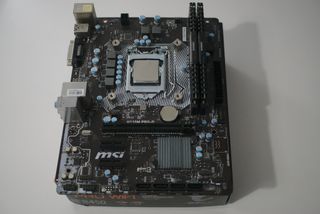

Now, we'll need to install the CPU cooler. Depending on the cooler you've purchased, you may have a layer of thermal paste already applied. If not, we'll need to do this before installing the cooler. (Tip: less is more.) The manual will run you through the process of installation, which can vary between coolers and manufacturers.
Especially with aftermarket coolers — both water and air — you'll need to pay close attention to the manual that comes with the product. This is why it's better to do all these steps with the motherboard outside the PC case for easier handling.
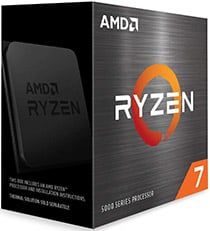
The Ryzen 5 and Ryzen 9 CPUs are attractive options, but for a middle-ground the Ryzen 7 5800X excels.
After many years of falling behind Intel, AMD has come leaps and bounds with Ryzen, and this latest generation is even better. There has never been a better time to hop over to team red, and the Ryzen 5 5600X is the perfect entry point for most PCs. There's even an included cooler to get you up and running.
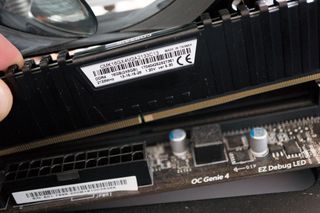
RAM is a sensitive component and, as such, should be handled with care. It's recommended that contact be avoided with the pins on the underside of each module. The RAM slots on a motherboard are located to the right of the CPU. Do check the motherboard manual as to which RAM slots are to be used, depending on how many sticks you have.


G.SKILL TridentZ RAM modules not only perform well with satisfactory latency, frequency, and capacity; they also look pretty awesome with built-in RGB lighting. Yes, you can now have your RAM modules glow in the dark.
It's vital to choose RAM that will be best matched with the motherboard and CPU, and this 3200MHz kit is excellent for the Ryzen 5 5600X and accompanying motherboard. There's also room for some tuning at a later date when you need a little more from your system memory.

With the CPU and RAM installed, the motherboard is now ready to boot. If you're using a Ryzen or Intel CPU without integrated graphics processing (our 5600X is one such CPU), we'll also need to install our GPU here to get an output from the motherboard.
Unpack the GPU from its box and carefully seat it into the top-most PCIe slot. Press down until you hear it click. The GPU should be fine sat atop of the motherboard, but you may need to allow the backplate to hang over the edge of the motherboard box so it can lie flush with the board itself.
All we require now is power. Reference your motherboard and PSU manuals to sort through the right cables and connectors.
Usually, to turn on a PC, you'll want to hit the power button, but since our PC is not technically inside a case yet, we have no power button. Luckily, we don't require the power button to turn everything on. We can emulate a physical button by simply using a screwdriver to create a bridge between the to POWER_SW pins on the motherboard.

Again, consult your motherboard manual to locate these pins. By simply making contact with the + and - pins for POWER_SW we're telling the motherboard to turn the system on. It's precisely what happens when you hit the power button on your PC case. Give it a few attempts if you can't quite make the connection between the two pins.
If everything boots through the BIOS and you see the splash screen, go into the setup by hitting the DEL key as the system cycles. Check that all your RAM is registered here. All good? Shut everything down and disconnect all the cables, removing the GPU and placing it back into its protective wrapping. It's now time to install the PC inside the case.

The PSU is the most critical component of any PC. It provides the juice required for all the computing magic to take place. Depending on the case you've purchased, we'll need to install the unit with the fan facing up or down. To determine which is most optimal, check if you have a vent at the bottom of the case. If so, face the PSU fan downwards.
You'll want to have all your cables connected to the PSU prior to installing it to make your job easier. Depending on the PSU you've purchased, it may be one of the following:
Fully and semi-modular PSUs are the easiest to work with as you'll have an easier time making sure all cables look neat and tidy.


The best power plant for your PC
You'll find it difficult to find a better value PSU than this EVGA example. It's rated for 80 Plus Platinum and has enough power for gaming PCs.
The PSU is the most critical component inside your PC case. It's what provides power to all other components and, as such, should be able to supply a reliable current. You can trust this PSU to provide clean, stable power.
With the CPU, the cooler, and RAM modules installed, the motherboard is ready to be screwed to the backplate inside the case. First, we need to install the I/O shield, a long piece of metal that has cutouts for all the rear ports and connections. This is optional, but recommended accessory helps provide electromagnetic interference (EMI) protection.

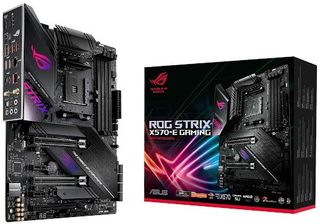
AMD Ryzen 5 5600X motherboards may be mid-tier, but they can stretch their legs with an X570 chipset-touting motherboard like the ASUS ROG Strix X570-E. Not only would you be able to overlock the CPU without issue, but you also enjoy PCIe 4.0 support, high-quality components, Wi-Fi 6, and Gen 4 M.2 slots capable of unidirectional transfer speeds up to 64GB/s, rapid LAN ports, and plenty of RGB options to light up your office.
Motherboards allow for the CPU, memory, storage, GPU, and all other components to communicate with one another, and the ASUS X570-E Gaming is a great solution. It's reliable, houses premium parts, has a ton of features, and has a solid UEFI setup that allows you to overclock your system easily.

Storage drives are essential devices that hold not only the operating system but also all programs, personal media, and all other data. It's recommended to use an SSD (be it M.2 or 2.5-inch) drive for the primary OS partition, which enables quick booting and reliable performance. Data can be stored on traditional (3.5-inch) mechanical drives.
M.2 PCIe NVMe drives are the fastest with SATA M.2 and 2.5-inch drives coming in second. 3.5-inch drives come in last for speed but are the most affordable, especially at higher capacities.
Depending on the case and how drive bays are configured, M.2, 2.5- and 3.5-inch drives may be able to be installed at the same points or using dedicated brackets. Be sure to double-check the PC case manual. We'll go over how your PC case may have both configured below.
M.2 SSD

2.5-inch SSD
Some cases will simply allow you to screw in a 2.5-inch drive to a bay that also supports larger 3.5-inch drives, though more modern PC cases allow you to use brackets to the rear of the motherboard tray. For the latter:
3.5-inch HDD

Insane performance at an affordable price
Samsung has long been at the forefront of the SSD market, and its latest is undoubtedly the greatest with incredible performance.
Since the ASUS motherboard we selected has M.2 support, we can opt for a super-fast SSD. Samsung's latest 970 EVO Plus is incredibly fast, perfect for both Windows 10 and games. With 500GB, you'll be able to install the OS and then a few programs and games too, though if your budget can stretch it, we'd always recommend installing games on a different drive to the OS.
With all significant components now installed, it's time to hook everything up to the power supply and motherboard. Generally speaking, it's best to start with the power to the motherboard itself.

Next, we need to connect the storage drives to the motherboard, using SATA data cables. These are mostly smaller versions of their power siblings that carry data instead. The motherboard usually has SATA ports located to the lower-right hand-side. It doesn't matter which ports are used. Much like the power cables, route these through cut-outs and grommets to the drive bays and mounts.
We now have power to our storage drives and the motherboard, as well as data channels between drives and the mainboard. All that's left is to connect front panel I/O and other optional connectors (front panel USB, HD audio, etc.). Connecting the front panel I/O, which includes the power switch, reset switch, HDD activity LED, and power LED can be a tricky step.
These pins stand up from the motherboard, which requires a careful approach when plugging in the small connectors. The motherboard manual should provide information as to the layout of these pins and what they correspond to — though usually the below layout is used:

The front USB 3.0 and HD audio pins can be located on the motherboard. Again, refer to the manual for exact placement as not all motherboards are created equal.
For added cooling capacity (and room for overclocking or more stable operation), throwing in an extra fan or two is worthwhile. PC cases may come with fans pre-installed, but if not, it's simple to screw them into fan mounts. Just be sure to align them correctly and have the blades pointing the correct way. Fans can have small arrows on the side that show which way the blades spin and where airflow will be directed.
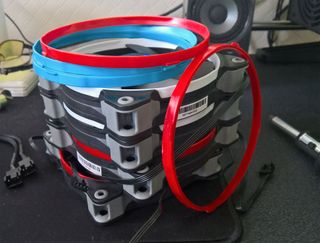
Note: some cases may require you to install fans before inserting the motherboard, especially for the top exhaust. Fans can either be plugged into a motherboard or into the PSU directly using an adapter. We'd always recommend the motherboard due to the ability to control the fans intelligently depending on system temperatures.
Fan headers can be located on the motherboard itself, where the 3 (or 4) pin connectors can be inserted.

Need some extra power for gaming and intense workloads? The best graphics card is a must-have. As a bonus, it's straightforward to install a graphics card. We usually leave the GPU until last because of how much space they typically take within the chassis.
